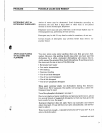
PROBLEM
POSSIBLE CAUSE AND REMEDY
TO REMOVE SPOTS
AND FILM
ETCHING
YELLOW OR
BROWN FILM
FORMATION
.
Try
a vinegar rinse. Remove all metal utensils and wash load as usual but
omit the dry portion of the cycle. With load still in dishwasher, set a bowl
containing 2 cups (5oO ml) of white vinegar on bottom rack. Run dish-
washer through a complete cycle.
Caused by using too
like surface cannot be
much detergent in soft
removed because metal
from the surface of the glass. To prevent this
gent when your water supply is naturally soft
water. This milky film-
ions have been removed
problem, use less deter-
or when you use a water
softener. Also, wash glass~rare in shortest cycle that will get them clean.
e
Tea or coffee stains in cups can be removed by hand using a solution of
1/2 cup bleach and 3 cups of warm water.
An over-all yellow or brown film on dishes can be caused by iron
deposits in water. Glassware becomes yellow or brown but is still
transparent. The installation of an iron filter in the water supply line
removes the cause of this problem and is the only permanent solution.
For more complete information, contact your local water conditioning
company.
Yellow film on sterling silver can result when copper utensils are
washed in the same load.
CHIPPING OF CHINA
Rough handling of dishes ~vill cause chipping. Load tvith care. SL)at
AND GLASSWARE
ciishes firmly in the racks so they cannot be dislodgt’d, Glasses must
lean against the pins, and the rim of the glass should rest on the
bottom of the rack. When placing tall glass~vare and stemlvare in the
dishwasher, check to make certain that they will clear the top of the
tub. Glasses and stemware should always be piaced in the upper rack.
NEVER in the lower rack. (See section on loading)
WATER STANDS IN
SUMP AT BOTTOM
OF TUB
Water remaining in the sump at end of cycle is normal. This
water is--~
clean and keeps the pump primed and the water seal moist and active.
11


















